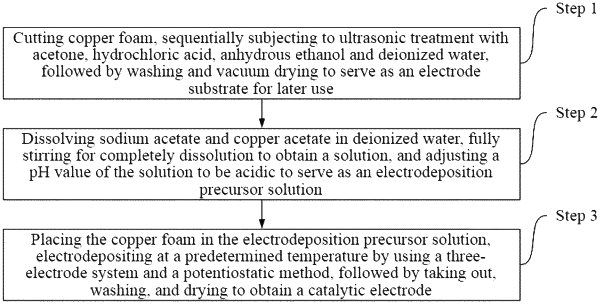| CPC C25B 11/077 (2021.01) [C25B 1/27 (2021.01); C25B 11/031 (2021.01); C25B 11/061 (2021.01); C25D 9/08 (2013.01)] | 4 Claims |

|
1. A preparation method of a three-dimensional structured electric cathode based on cuprous oxide for reduction of nitrate and electrocatalytic ammonia production, comprising the following steps:
step 1: cutting copper foam (CF), sequentially subjecting to ultrasonic treatment with acetone, hydrochloric acid, anhydrous ethanol and deionized water, followed by washing and vacuum drying to serve as an electrode substrate for later use;
step 2: dissolving sodium acetate and copper acetate in deionized water, fully stirring for completely dissolution to obtain a solution, and adjusting a pH value of the solution to be acidic to serve as an electrodeposition precursor solution;
step 3: placing the copper foam in the electrodeposition precursor solution, electrodepositing at a predetermined temperature by using a platinum sheet as a counter electrode, an Ag/AgCl as a reference electrode and a working electrode adopts the copper foam, and a potentiostatic method comprises: a deposition potential of −0.2 Volt-−0.6 Volt, and a deposition duration of 20-120 minutes, followed by taking out, washing, and drying to obtain a Cu2O/Cu CF catalytic electrode, and an exposed crystal plane of the catalytic electrode is a Cu2O (111) crystal plane; and
step 4: the catalytic electrode obtained from steps 1-3 is immersed in an electrolyte composed of 3.55 g of anhydrous sodium sulfate and 0.051 g of potassium nitrate dissolved in 50 mL of deionized water, with argon gas introduced into the electrolyte for 30 minutes to ensure an anaerobic environment and eliminate oxygen interference during a subsequent reaction process, followed by recording the relationship between potential and current density using linear sweep voltammetry (LSV) within a set potential window to investigate an electrochemical activity of a material for the reduction of nitrate and electrocatalytic ammonia production.
|